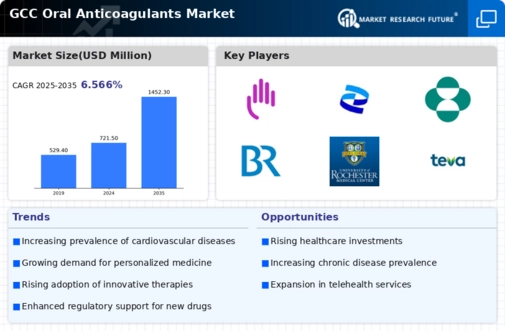Increasing Aging Population
The oral anticoagulants market is experiencing growth due to the increasing aging population in the GCC region. As individuals age, the risk of developing cardiovascular diseases and thromboembolic disorders rises significantly. This demographic shift is expected to lead to a higher demand for anticoagulant therapies. According to recent statistics, the population aged 65 and older in the GCC is projected to reach approximately 10% by 2030. This trend suggests a growing patient base requiring effective management of blood clotting disorders, thereby driving the oral anticoagulants market. Furthermore, healthcare systems are adapting to this demographic change by enhancing their focus on preventive care and chronic disease management, which includes the use of oral anticoagulants.
Rising Healthcare Expenditure
The oral anticoagulants market is positively influenced by the rising healthcare expenditure across the GCC countries. Governments are increasingly investing in healthcare infrastructure and services, which facilitates better access to advanced medical treatments, including anticoagulants. For instance, healthcare spending in the GCC is expected to grow at a CAGR of around 7% over the next few years. This increase in funding allows for the introduction of innovative therapies and improved patient care, which is crucial for managing conditions that require anticoagulation. As healthcare systems evolve, the availability of oral anticoagulants is likely to expand, further propelling market growth.
Advancements in Drug Formulations
The oral anticoagulants market is witnessing advancements in drug formulations that enhance patient compliance and treatment outcomes. Newer anticoagulants are being developed with improved safety profiles and dosing regimens, which are appealing to both patients and healthcare providers. For example, the introduction of fixed-dose oral anticoagulants simplifies treatment protocols, reducing the need for regular monitoring. This innovation is particularly relevant in the GCC, where healthcare providers are seeking efficient solutions to manage anticoagulation therapy. As these advancements continue to emerge, they are likely to stimulate growth in the oral anticoagulants market, as patients are more inclined to adhere to treatment plans that are easier to manage.
Regulatory Support for Innovative Therapies
The oral anticoagulants market is supported by regulatory bodies in the GCC that are increasingly favorable towards the approval of innovative therapies. Streamlined regulatory processes and initiatives aimed at expediting the review of new drugs are encouraging pharmaceutical companies to invest in research and development. This regulatory environment is crucial for the introduction of novel oral anticoagulants that offer enhanced efficacy and safety. As a result, the market is expected to see a rise in the availability of new treatment options, which could potentially address unmet medical needs in the region. The proactive stance of regulatory agencies is likely to foster a competitive landscape, further driving the oral anticoagulants market.
Growing Awareness of Thromboembolic Disorders
the oral anticoagulants market is experiencing growing awareness of thromboembolic disorders among healthcare professionals and the general public in the GCC. Educational campaigns and initiatives aimed at increasing knowledge about the risks and symptoms of conditions such as deep vein thrombosis and pulmonary embolism are becoming more prevalent. This heightened awareness is leading to earlier diagnosis and treatment, which in turn drives demand for oral anticoagulants. As more patients seek treatment options, the market is expected to expand. Additionally, healthcare providers are increasingly recognizing the importance of anticoagulation therapy in preventing serious complications, further supporting the oral anticoagulants market.

















Leave a Comment